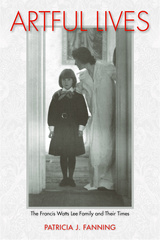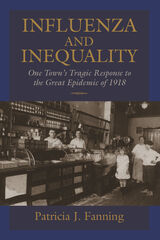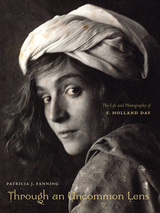3 books about Fanning, Patricia J.

Artful Lives
The Francis Watts Lee Family and Their Times
Patricia J. Fanning
University of Massachusetts Press, 2016
Francis Watts Lee and his family hold a special place in the history of American photography. F. Holland Day completed a series of remarkable photographs of Lee's daughter Peggy, and the striking portrait of the child and her mother titled Blessed Art Thou among Women is one of Gertrude Käsebier's most iconic compositions. In Artful Lives, Patricia J. Fanning uses these and other significant images as guideposts to explore the Lee family and the art and culture of their age.
A social reform advocate, Francis Watts Lee was an artistic photographer and a talented printer, part of the circle of avant-garde artists and intellectuals who formed Boston's bohemia. He married twice, first Agnes Rand, an award-winning poet and children's book author, and later, after their divorce, Marion Lewis Chamberlain, a librarian and MIT-trained architect. Francis and Agnes's eldest daughter, Peggy, who was so integral to the work of pioneer Pictorialists, died at age seven of juvenile diabetes. Her sister, Alice, who lost her hearing in infancy, became a wood carver and sculptor.
Utilizing previously unknown family archives and institutional sources, Fanning traces the Lee family's story in the context of major artistic, political, social, and religious trends, including the Arts and Crafts movement, Christian Socialism, and Aestheticism, while also showing how their experiences reflected the national culture's evolving conceptions of family, gender, childhood, medicine, deaf education, and mourning. This richly drawn and gracefully written account of one family informs our understanding of this vibrant era, in Boston and well beyond.
A social reform advocate, Francis Watts Lee was an artistic photographer and a talented printer, part of the circle of avant-garde artists and intellectuals who formed Boston's bohemia. He married twice, first Agnes Rand, an award-winning poet and children's book author, and later, after their divorce, Marion Lewis Chamberlain, a librarian and MIT-trained architect. Francis and Agnes's eldest daughter, Peggy, who was so integral to the work of pioneer Pictorialists, died at age seven of juvenile diabetes. Her sister, Alice, who lost her hearing in infancy, became a wood carver and sculptor.
Utilizing previously unknown family archives and institutional sources, Fanning traces the Lee family's story in the context of major artistic, political, social, and religious trends, including the Arts and Crafts movement, Christian Socialism, and Aestheticism, while also showing how their experiences reflected the national culture's evolving conceptions of family, gender, childhood, medicine, deaf education, and mourning. This richly drawn and gracefully written account of one family informs our understanding of this vibrant era, in Boston and well beyond.
[more]

Influenza and Inequality
One Town's Tragic Response to the Great Epidemic of 1918
Patricia J. Fanning
University of Massachusetts Press, 2010
The influenza epidemic of 1918 was one of the worst medical disasters in human history, taking close to thirty million lives worldwide in less than a year, including more than 500,000 in the United States. What made this pandemic even more frightening was the fact that it occurred when death rates for most common infectious diseases were diminishing. Still, an epidemic is not merely a medical crisis; it has sociological, psychological, and political dimensions as well. In Influenza and Inequality, Patricia J. Fanning examines these other dimensions and brings to life this terrible episode of epidemic disease by tracing its path through the town of Norwood, Massachusetts.
By 1918, Norwood was a small, ethnically diverse, industrialized, and stratified community. Ink, printing, and tanning factories were owned by wealthy families who lived privileged lives. These industries attracted immigrant laborers who made their homes in several ethnic neighborhoods and endured prejudice and discrimination at the hands of native residents. When the epidemic struck, the immigrant neighborhoods were most affected; a fact that played a significant role in the town's response—with tragic results.
This close analysis of one town's struggle illuminates how even well-intentioned elite groups may adopt and implement strategies that can exacerbate rather than relieve a medical crisis. It is a cautionary tale that demonstrates how social behavior can be a fundamental predictor of the epidemic curve, a community's response to crisis, and the consequences of those actions.
By 1918, Norwood was a small, ethnically diverse, industrialized, and stratified community. Ink, printing, and tanning factories were owned by wealthy families who lived privileged lives. These industries attracted immigrant laborers who made their homes in several ethnic neighborhoods and endured prejudice and discrimination at the hands of native residents. When the epidemic struck, the immigrant neighborhoods were most affected; a fact that played a significant role in the town's response—with tragic results.
This close analysis of one town's struggle illuminates how even well-intentioned elite groups may adopt and implement strategies that can exacerbate rather than relieve a medical crisis. It is a cautionary tale that demonstrates how social behavior can be a fundamental predictor of the epidemic curve, a community's response to crisis, and the consequences of those actions.
[more]

Through an Uncommon Lens
The Life and Photography of F. Holland Day
Patricia J. Fanning
University of Massachusetts Press, 2008
Based in the Boston area, F. Holland Day (1864–1933) was a central figure in artistic circles on both sides of the Atlantic. Publisher of Oscar Wilde and Stephen Crane, mentor to a young Kahlil Gibran, adviser and friend to photographers Alvin Langdon Coburn and Edward Steichen, Day lived a life devoted to art and beauty. At the turn of the twentieth century, his reputation rivaled that of Alfred Stieglitz. A pioneer in the field of pictorial photography, Day was also an influential book publisher in the Arts and Crafts tradition. He cofounded the publishing company of Copeland and Day, which issued more than a hundred titles between 1893 and 1899. In addition, he embraced a unique sense of social responsibility and a commitment to historic preservation. Colorful and sometimes eccentric, Day was best known for his stunningly original, brilliantly executed, and sometimes controversial photographic images of blacks, children, and allegorical subjects. His determination to promote photography as a fine art led him to create photographic representations of the crucifixion of Christ, studies for which he was his own model. Although he continued to mentor young artists until his death, ill health caused Day to spend the last fourteen years of his life inside his home in Norwood, Massachusetts. By the time he died in 1933, he was virtually unknown, but in recent years there has been a resurgence of interest in his art. Responding to this renewed interest, Patricia Fanning has written an impressive biography—one that draws on previously unavailable archival material and is attuned to the historical and cultural contexts in which Day lived and worked. The book is illustrated with more than a hundred photographs, including 32 duotone illustrations of the artist's work.
[more]
READERS
Browse our collection.
PUBLISHERS
See BiblioVault's publisher services.
STUDENT SERVICES
Files for college accessibility offices.
UChicago Accessibility Resources
home | accessibility | search | about | contact us
BiblioVault ® 2001 - 2024
The University of Chicago Press









